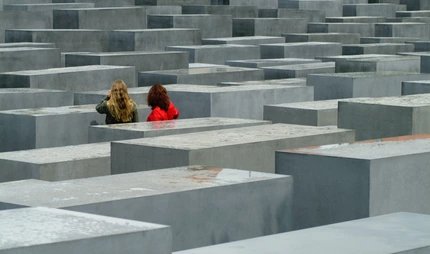
Alter Jüdischer Friedhof (Old Jewish Cemetery)
Where Moses Mendelssohn was buried
Once a Jewish cemetery, then destroyed by the Nazis, the Alter Jüdischer Friedhof in Berlin has been restored again.
Famous personalities of Berlin Jewry once rested on the site in Hamburger Straße. Today, the cemetery is the oldest recognisable burial ground in Berlin's city centre.
The beginnings
After the expulsion of many Jews from Vienna, the then Elector Friedrich Wilhelm issues an edict of admission. in 1671, 50 Jewish families settled in Berlin again after more than a hundred years. The newly formed Jewish community is given a burial ground outside the city walls near Oranienburger Straße in the Rosenthal neighbourhood. Thousands of Jews are said to have been buried on the 5,900 square metre site. People were buried here between 1672 and 1827.
Probably the most famous grave is that of the German philosopher Moses Mendelssohn, who has been buried here since 1786. A gravestone, which has already been reconstructed several times, commemorates the famous Enlightenment philosopher. Mendelssohn is still regarded today as the pioneer of the Haskalah, the Jewish Enlightenment. in 1763, he won first place in the 'Royal Academy' with a philosophical treatise. Nicknamed the 'German Socrates' by his followers, Mendelssohn was a close friend of Gotthold Ephraim Lessing. He is considered to be the role model for the protagonist in Lessing's work Nathan the Wise.
Other famous personalities buried in the Old Jewish Cemetery include the famous rabbi and teacher of Moses Mendelsohn, David Hirschel Fraenkel, Veitel Heine Ephraim, court factor of Frederick the Great and builder of the magnificent Ephraim Palace, Marcus Herz and Jacob Herz Beer, the father of the composer and conductor Giacomo Meyerbeer.
After the closure
The closure of the cemetery was based on a Prussian hygiene decree issued in 1794. It stipulates that cemeteries within the city walls in residential areas are no longer permitted as burial sites. a new Jewish cemetery was opened in Schönhauser Allee in 1827. However, this was already too small in 1880 and had to be supplemented by the Jewish cemetery in Weißensee.
When the Jewish old people's home was built and opened in 1844, the entrance to the former cemetery was moved from Oranienburger Straße to Hamburger Straße. The old cemetery is preserved due to its perpetual right of rest and is used as a park for the approximately 120 residents of the retirement home. The cemetery grounds are also used by the nearby Jewish boys' school for nature lessons.
The Nazi era
From 1942 - during the Nazi era - the old people's home was used by the Secret State Police as a collection centre for around 55,000 Jewish residents. the old people's home and cemetery were destroyed in 1943. A splinter trench is dug through the cemetery. The bones of the dead are torn out of the ground and the gravestones smashed. In April 1945, 2,427 fallen soldiers and civilians killed in street fighting are buried in mass graves in the cemetery.
Post-war period

in 1948, the cemetery is returned to the Jewish community. Part of the cemetery grounds are converted into a public green space in the 1970s. A sculpture entitled "Jewish Victims of Fascism" by Will Lammert is erected next to a memorial stone on the site of the destroyed old people's home.
in 2007-2008, the cemetery area is redesigned and reorganised and the cemetery area is made visible again. A water basin for ritual hand washing is set up in the entrance area, a prayer plaque is installed and information boards mark the Old Jewish Cemetery and the former Jewish old people's home as a memorial site.
Further information for your visit
Your visit to the former cemetery can be wonderfully combined with other institutions of Jewish history in Berlin. Not far from the cemetery is the Anne Frank Centre and the Museum of Otto Weidt's Workshop for the Blind. Every second Sunday of the month, there are free public tours through the rooms, which have been preserved in their original state.
The historical Jewish cemeteries can be discovered with the help of a digital guidance system. On site, visitors can use a QR code in German and English to find out about the history of the cemeteries, individual gravestones and the personalities buried there.
daily unlimited



